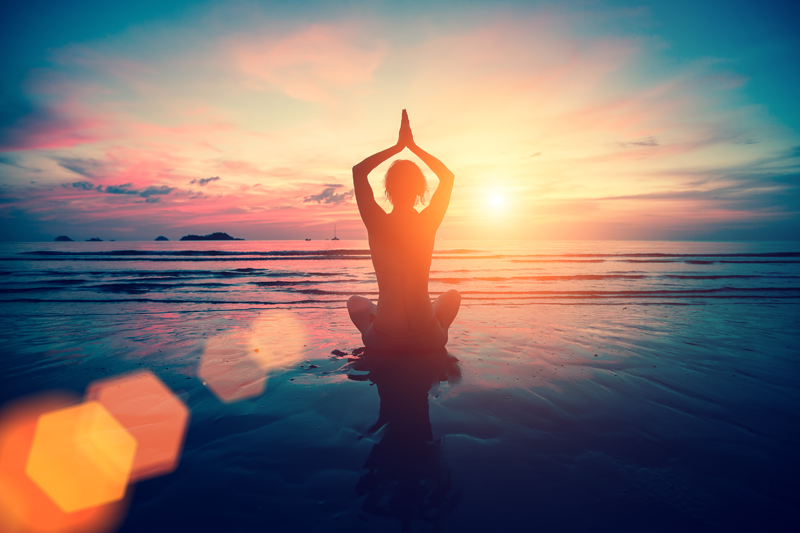Traditionally, yoga focusses on self-practice. Over the years, styles and techniques have been passed down from instructor to student on a one-to-one basis. While led Ashtanga classes have their place, one-to-one teaching offers a more personal approach to yoga. And that’s exactly what Mysore gives. In a Mysore class, you can learn at your own pace under the instruction of a teacher. If you want to get the most from your time on the yoga mat, there’s no better style than Mysore and we believe it’s the answer to everything. In this article, we explore Mysore: the answer to the universe.
What is Mysore Style?
The Mysore style teaches yoga in the traditional way, as taught by K. Pattabhi Jois in the Indian city of Mysore. The fame of the style has made the city a yoga hub with a large yoga tourism business.
Unlike regular yoga classes, Mysore is not “led” as a whole. Instead, the instruction is given on a one-to-one basis within a group setting. Each student in the class practices their own portion of the Ashtanga sequence of asanas and learns at their own pace. The teacher helps each practitioner individually through verbal instruction and physical adjustments. In a Mysore class, yogis learn the fixed order of asana and combine their movement with free breathing and sound. They learn how to breathe from one asana into the next so that each pose builds from the previous one.
Each yogi is given a routine according to their ability. Typically, beginner students are given a shorter sequence than those with more experience. As yogis develop more stamina, strength, flexibility and concentration, they are given additional postures to add to the routine. In Western “led” classes, people are used to learning multiple asanas at once, all while keeping up with the pace of the group. In Mysore classes, the postures are given one by one in sequential order. The structure of the class varies depending on how well the teacher can keep track of every student with a quick glance. If a student struggles with a posture, the teacher can suggest a modification that suits their needs. Learning the postures one by one also means that when the student is given a new pose, they can practice the sequence up to that asana before needing support again. Once they have reached the end of their personal routine, they can wind down with a few backbends and a finishing sequence. Deep backbends may help to release trauma; this can range from subtle emotions arising to cathartic releases of trauma that’s being stored in the body. Euphoria or crying are not uncommon, typically followed by a sense of release or emotional balance. If a posture has this effect, you should only move onto the next once emotional stability has been reached.
What Makes Mysore so Great?
Learn at Your Own Pace
One of the main benefits of Mysore is that you can learn at your own pace. Instead of keeping up with the pace of the class, you can practice each asana until you are totally happy with it. This is ideal for new yogis, as you can introduce the postures slowly and get to grips with them before moving onto the next. This also helps you to remember them better and prevents injury from silly mistakes. Mysore allows you to learn at your own pace – not someone else’s.
Flexible and Convenient
With Mysore, there isn’t a set “start” or “end” time for your practice. For instance, instead of attending a set class between 6 pm and 7 pm, the studio is often open for an entire morning, afternoon or evening. This means you can show up at a time convenient to you and practice for as long as you like. If you can’t make it into the studio one day, don’t panic! The one-to-one teaching will have shown you exactly what to do, so you can practice independently from the comfort of your home. This allows for flexible yoga practice.
One-to-One Support
In most Mysore classes, there is one instructor in the room and one or two assistants. Their job is to make sure each student is practising the poses with proper alignment and in the correct order. Often, students will tackle a pose that is complex but achievable with support. The instructor or assistant will move around the room and help you to get in and out of the pose safely.
Fewer Distractions
Mysore classes have fewer distractions than regular led classes. In a Mysore class, there is no teacher shouting out the poses or rushing you in and out of a particular asana. While the teacher is there for support, the majority of the class is spent on your own, working through the sequence at your own pace. Of course, the teacher is on hand if you need any guidance.
Community Support
There is something truly special about the Mysore community. With many students practising 6 days per week, you see the same faces every day. Over time, you start to form bonds and lasting relationships with likeminded individuals. Every day, you’re surrounded by other people who are challenging themselves and their limitations in the same way that you are. This leads to a feeling of community and support, even though everybody is working at their own pace.
In Summary
So, there you have it – Mysore: the answer to the universe. We believe that it is just that – the answer to everything. With the support of an experienced teacher, you can work through the Ashtanga poses and develop your skills as a yogi. Not only that, but you can form a deeper bond with yourself and with those around you. If you want to learn yoga in the traditional way, pack your yoga bag and head to a Mysore class. You won’t regret it!

